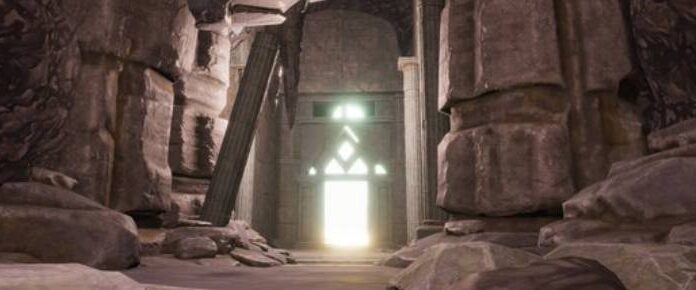
Today I want to try something a little different as we look at MMORPG history. Rather than focus in on a single title or moment in time, I am pulling back the camera to give an overview of an entire decade — in fact, the first decade that MMOs were officially a thing.
So join me as we travel back to the time of DeLoreans, A Flock of Seagulls, and genuinely good Ghostbuster movies as we look at how the MMO genre developed over the 1980s!
First out of the gate
While we could go back even further to see some of the proto-online games that existed in the ’60s and ’70s, the general consensus is that the proto MMO genre officially was born in the very first year of the 1980s.
Inspired by text adventure games (which were also a relatively new thing), the first “multi-user dungeon” was created by Richard Bartle and Roy Trubshaw in 1979. But it wasn’t until the following year that MUD1 went online in spring 1980 through the Essex University’s ARPANET, making it the first multiplayer online RPG. To be fair, around this time another online game called Milieu — created by Alan E. Kietz — started creeping through modem networks as well.
Other text-based MMOs began to appear by the middle of the decade, such as 1980’s Dungeons of Kesmai, Richard Bartle’s MUD2, Mark Jacobs’ Aradath, 1986’s Mirrorworld, 1988’s Gemstone II, and even an Apple II MUD called Eamon. About this time, Atari worked to create software (“The Learning Phone”) that allowed its 8-bit system to connect to online PLATO games in 1984.
One title, Sceptre of Goth (which was a rebranded Milieu), became the first commercial text-based MMO when it arrived in 1983. Sceptre is notable because of several well-known MMO devs who emerged from this project, including Scott Hartsman, J. Todd Coleman, Matt Firor, Rob Denton, and Meridian 59’s Andrew and Chris Kirmse.
The rise of online gaming portals
Online gaming portals and bulletin board systems emerged to help connect dial-up computers together. These included The Source (1979), CompuServe (1979), Minitel (1980), Delphi (1983), Viewtron (1983), Gamers World (1984), PlayNet (1984), Prodigy (1984), GEnie (1985), and Quantum Link (1985).
It should be noted that all of these services existed prior to the World Wide Web and common household internet access. They were all expensive, too, requiring users to pay by the hour. Many of these services snapped up MUDs to host, such as MegaWars and British Legends on CompuServe or Stellar Wars on GEnie.
Kelton Flinn and John Taylor got together to fashion a multiplayer dungeon crawler in college that eventually became 1985’s Islands of Kesmai. It was just an MMO with ASCII characters, but the novelty of online play and the addictive gameplay loop kept players involved.
College kid Richard Skrenta created a MUD in 1988 called Monster that allowed players to make their own “rooms” full of content. By doing this, the users became developers and helped the title continually expand.
By 1987, there was an open-source MUD called AberMUD that anyone could access and modify to create their own versions. This would later inspire DikuMUD, the key codebase that many MMOs such as EverQuest and World of Warcraft would use as a foundational base.
Other MUDs and BBS door titles popped up near the turn of the decade including Legends of the Red Dragon, Avalon, MTrek, TinyMUD, LPMud, and Galaxy I. There were other “firsts” in the genre, such as QuantumLink’s Rabbitjack Casino (1985) and a play-by-email game called Rim Worlds War (1986).
A graphical upgrade
Online games began to tiptoe into the graphical space by the bottom half of the decade. One of the first such games was 1987’s Air Warrior, which offered wireframe dogfighting between online players.
LucasFilm took a stab at an online graphical space with Habitat for the Commodore 64 in 1986. Part chat room, part roleplaying experience, and part player housing, Habitat became a weird offshoot of the genre that nevertheless presaged many trends (good and bad) for online games to come.
Kingdom of Drakkar debuted in 1989 as a graphical front-end update to an older MUD named Realm but with 8-bit graphics and a mouse-driven interface.
Another notable game was GEnie’s A-Maze-ing, a 3-D online shooter that was a descendant of the old Maze Wars from the ’70s.
Sure, it wasn’t until the 1990s that the technology, connectivity, and popularity surrounding this genre would result in actual full-fledged graphical MMORPGs, but we wouldn’t have gotten there if the 1980s hadn’t laid the groundwork for it to happen.
 Believe it or not, MMOs did exist prior to 2004! Every two weeks, The Game Archaeologist looks back at classic online games and their history to learn a thing or two about where the industry came from… and where it might be heading.
Believe it or not, MMOs did exist prior to 2004! Every two weeks, The Game Archaeologist looks back at classic online games and their history to learn a thing or two about where the industry came from… and where it might be heading.

















